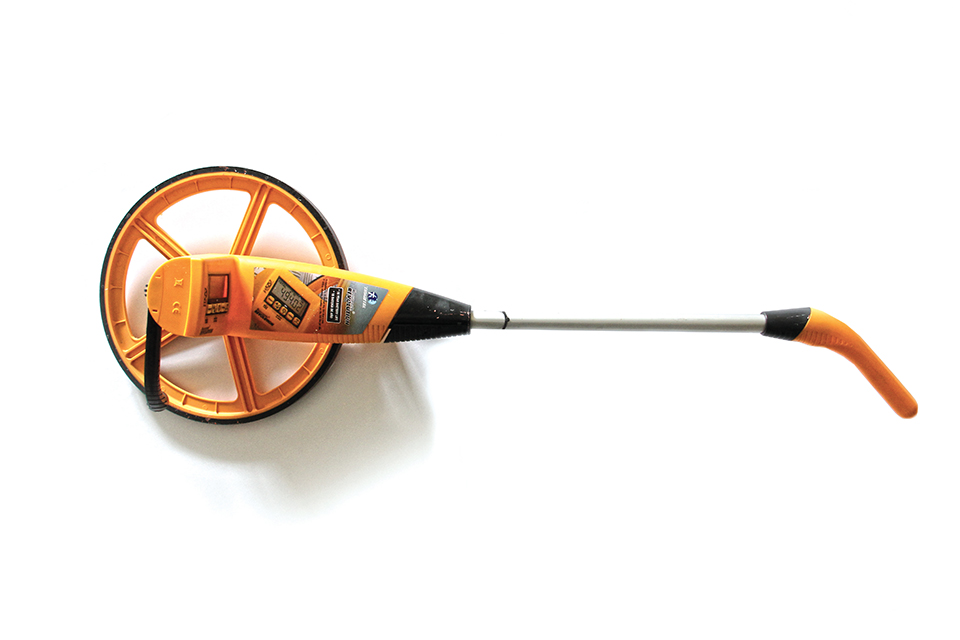Measuring a Race Course

Only a USA Track and Field (USATF)-certified course can count for a record; only a runner performing on a certified course can be ranked. A certified course is at least the distance stated; while your GPS may show a longer distance, that’s perfectly fine for USATF (more on this later). If a course remains unchanged, certification is good for ten years. Races do not “own” courses; anyone may use that certified course for a race, though most want some small change to the start or finish, Spoonts said. Long-time runners will remember the infamous “Dog Pound Loop,” which was used over and over for a variety of 5Ks that started at Auditorium Shores.
One key fact in course certification is that the shortest distance is measured. That means that Spoonts is riding every tangent—there’s no hugging the curb as he takes a corner. This can account for much of the difference in a runner’s GPS reading; most runners deep in the pack, unlike the elites, are not running tangents. Note that running a tangent (a straight line that just touches a curve) is not the same as “cutting the course,” which refers to taking a short cut (for example, moving off the route and onto a side street or taking an alternate, abbreviated route).
Spoonts rides the proposed course twice. The first time, he stops to hammer a pin into the road on the runner’s side to mark each mile; he also has to mark each 5K. Spoonts makes notes about where the pin is located, resets his counter, and pedals on. After he’s done, he has to do it again to check locations and distances. Measuring a half marathon course like 3M takes approximately 5-6 hours.
That measuring wheel? While it’s handy for measuring long lengths, it’s not the device used to determine the distance of a road race. What’s used is a bike equipped with a device called a Jones Counter. Spoonts first calibrates his bike on a special 500-meter course that he created, an entirely different certification procedure.
Anybody can certify a course, although there’s usually a mentorship involved; Spoonts learned his craft from John Ferguson. When Ferguson moved away from Austin, he helped Spoonts with the tricks of the trade. Course certifiers “pretty much stay in the area where they live,” Spoonts explained, though that’s a courtesy, not a requirement. The more practice, the easier it gets—and math skills help (Ferguson was a math teacher). There are a lot of calculations involved, as the Jones Counter measures “counts,” a certain number of which add up to one revolution of the bike wheel. Courses are measured in both miles and meters.
The certification paperwork that must be filed is very involved. “It takes as long to fill out the forms as it does to ride the course,” said Spoonts. He explained that the map and notations are so detailed, “I could even give it to anyone to mark.” That’s important, because an army of volunteers and paid race personnel use that information to place markers, aid stations, signs, barricades, police officers—you name it. Just to be sure the front runners are on course, race director John Conley works with Jack & Adam’s Bicycles to find qualified bike escorts to lead the way.
Runners get excited to see the pins in the road, which Spoonts places a few months in advance of the race. Some pins may last all year long, while others disappear thanks to road construction and wear and tear. When multiple courses use the same stretch of road, the pins can get a bit confusing, so Spoonts may remove some for clarity. He cited Great Northern as an example; 3M runners will head south down the road while Austin Marathon runners will move uphill and to the north on the same stretch.
The 3M Half Marathon is 20 years old in 2014. There’s a new start time (7 a.m.), and the race is capped at 8,000 participants. Though the course had to be rerouted last year due to a conflict with the University of Texas, this race is back on the 2012 route. Street sign notifications go up along the course approximately two weeks ahead of race date—Sunday, January 19—but you can get out now and play “spot the pin” while running. When you do, say a little thank you to your friendly course certifier, Danny Spoonts.
Directions for certifying a race course can be found at www.usatf.org/Products-/-Services/Course-Certifications/USATF-Certified-Courses/Certify-Your-Course.aspx






